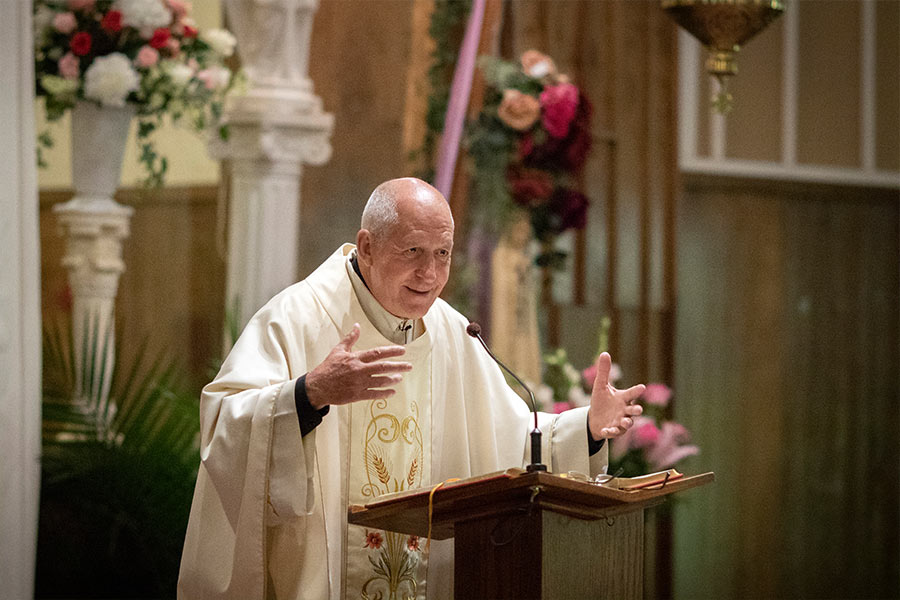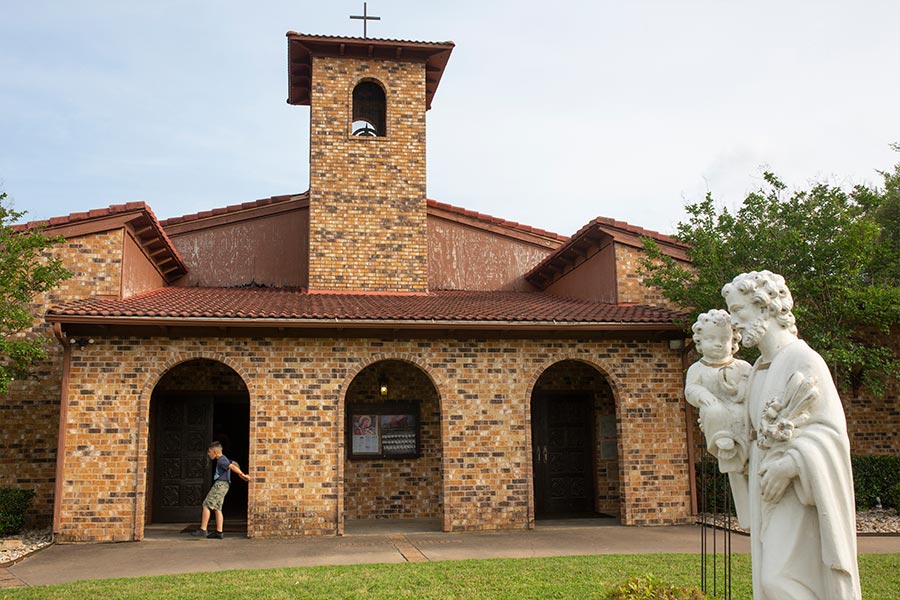Hispanic-Latino roots run deep within the Diocese of Fort Worth: Part 2

Fr. Sergio Rizo celebrates Mass at St. Joseph Catholic Church in Cleburne, Saturday, May 25, 2019. (NTC/Rodger Mallison)
Catholic Hispanic roots run deep in present-day Texas
Father Sergio Rizo, pastor of St. Joseph Parish in Cleburne, said it is important to remember that the roots of many Hispanics can be traced directly to the soil that is now part of Texas. The facts bear him out.
The land we now know as Texas had a long history of being part of New Spain until Mexico won independence from Spain in 1821. Fifteen years before Mexican independence, about 7,000 people lived in present-day Texas, according to the Texas State Historical Association (TSHA). By 1831, that number had nearly tripled to 20,000 according to the same TSHA report.
By 1876, when St. Stanislaus — later to become St. Patrick — became the first parish in the present Diocese of Fort Worth, migration to North Texas was coming from all directions. Hispanics, whose native roots in Texas extended generations, joined immigrants from Mexico, Germany, Italy, Poland, and countless other nations, as well as several states in the United States, to settle in North Texas. At the time, our diocese was still part of the Diocese of Galveston.
By 1900, 10 years after the Diocese of Dallas was formed, 17 of today’s parishes inside the present Diocese of Fort Worth were formed. At that time, our diocese was part of the Diocese of Dallas. Among those churches was St. Joseph in Cleburne, where Fr. Rizo has served for 28 years.
Incorporated into the present St. Joseph Church foundation is an engraved block that was once part of Mission San José in San Antonio in 1741. The cornerstone reinforces in many ways the foundation of the Catholic Church in Texas, dating back to the influence of the Hispanic cultures of the mission era.
Fr. Rizo commented that a strong devotion to Our Lady of Guadalupe, especially among Hispanics of Mexican descent, has strengthened the faithful for generations.
In the 1920s, after the revolutionary Mexican government imposed anti-cleric laws that eventually sparked the Cristero Rebellion, Catholics Churches in Mexico were destroyed and many priests were killed.
The total number of priests serving 15 million Catholics in Mexico was reduced from 4,500 clergy to only 334 priests “licensed” by the government. The others had been purged by expulsion, murder, and forced emigration.
According many reports, hundreds of thousands of Mexicans immigrated to the United States to escape widespread persecution.

St. Joseph Catholic Church, in Cleburne, has an engraved block that was once part of Mission San José in San Antonio in 1741. (NTC/Rodger Mallison)
Keeping the faith
Fr. Sergio said, however, that the Mexican people did not lose their faith, learning to endure silently through prayer and their devotion to Our Lady of Guadalupe.
“Almost the entire Church was left without sacraments, without clergy. The people were left with private devotions, with images of the Blessed Mother,” Father Rizo said.
“I firmly believe that Mexico has kept the faith all these years, thanks to their devotion to Our Lady of Guadalupe.”
That enduring faith under the direst circumstances has been passed on for generations, Fr. Sergio said, strengthening the Church in the Diocese of Fort Worth and elsewhere.
Shepherds caring for the parishes that lie within the boundaries of the present Diocese of Fort Worth have long appreciated the gifts that the faithful of Latino descent bring to Christ’s Church in North Texas.
A diverse group, Catholic Hispanic-Americans generally hail from or have family roots in Mexico, Guatemala, El Salvador and other nations in Central and South America, as well as Cuba, Puerto Rico, and other Caribbean countries.
The bishops’ actions have demonstrated a priority in ministering to Hispanics as these faithful Catholics, in turn, have continued to build up the local Church.
In 1902, for example, Diocese of Dallas Bishop Joseph P. Lynch reached out to Claretian Missionary (CMF) priests for assistance.
In a 1942 letter, referenced in the Diocese of Dallas Archives, Bishop Lynch wrote:
“I first formed an acquaintance with this estimable missionary Congregation in 1902, when I asked Father Camillo Torrente to come from San Antonio to Parker County, Texas, to become ‘locum tenens’ of the Weatherford parish … the missionary also attended Rock Creek, a mining camp located between Weatherford and Mineral Wells. The miners were principally Mexican and the district public school was used as a church.”
The bishop went on to describe how other Claretian missionary priests later joined the ministry to assume pastoral care of the growing number of Hispanics throughout the area.
